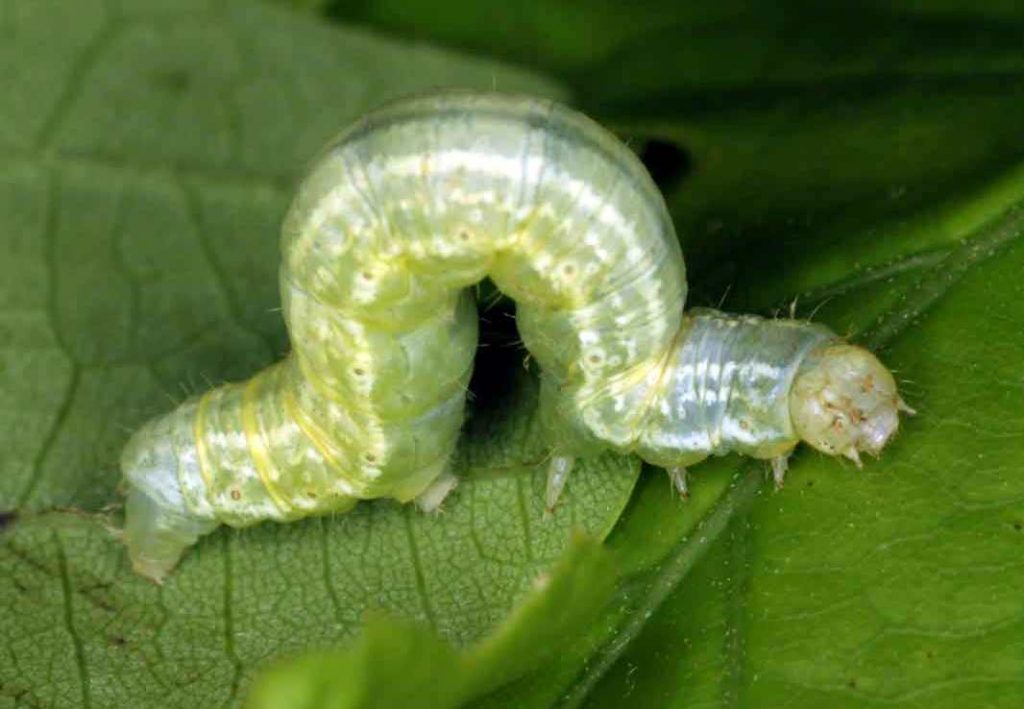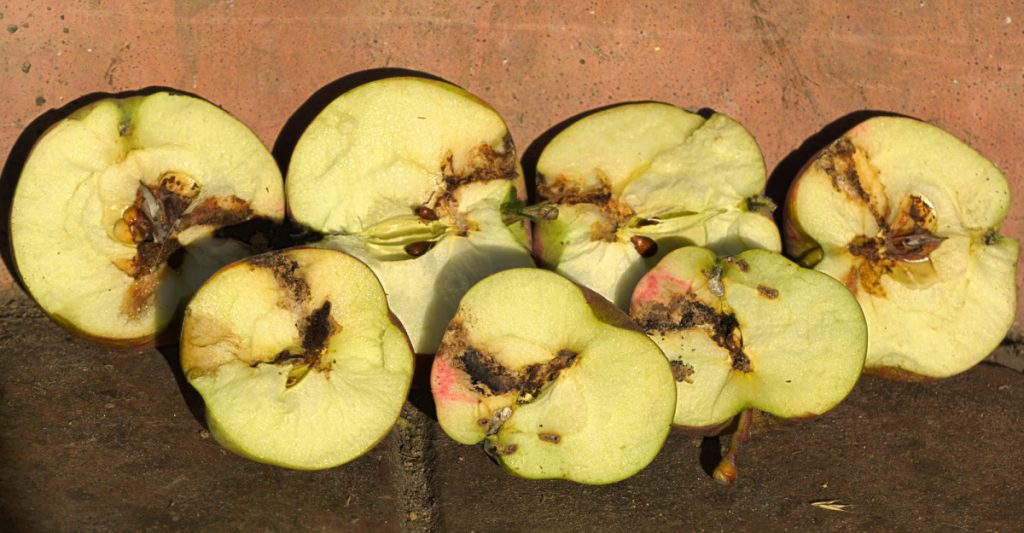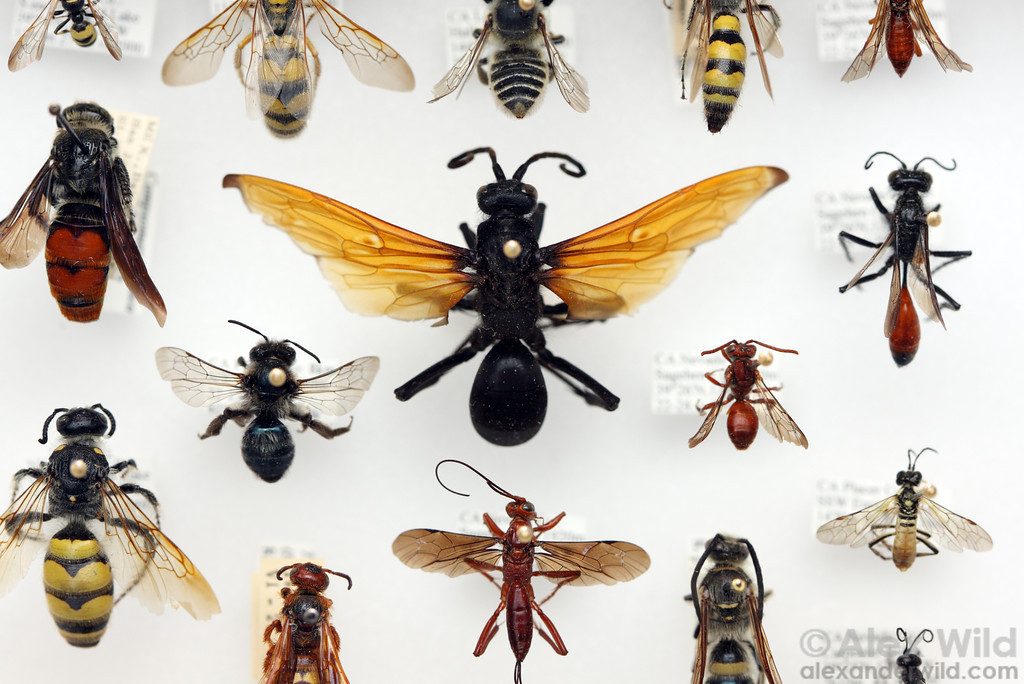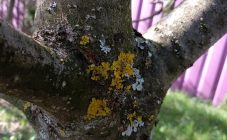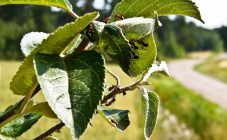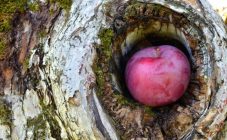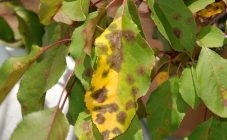Content:
Modern gardens often suffer from the invasion of such an insect as the apple moth. The butterfly of this pest itself will not only not attract special attention to its person, but also will not do much harm. The maximum harm to apple trees and other fruit trees is caused by its spineless representative - in the form of caterpillars that hide among the foliage and simply destroy the tree and fruits. After all, the moth eats not only apples, but also leaves, as well as young shoots.
Features of the apple moth
This small insect can be found in almost every garden where apples are found. A small nondescript butterfly with a wingspan of up to 1.8 cm has an unattractive brown color. The wings are gray and have dark stripes. At the end of each large wing is a yellow circle. The second pair of wings is smaller in size, light brown in color with a fringe at the end.
The caterpillar of this pest carries a great danger to gardens. It is light, sometimes light green or beige-pink, with a dark brown head. By the oldest age, the caterpillar becomes approximately 1.8 cm.
Pest development stages
Having chosen an object for defeat, the moth moth lays its eggs from the shady side of the tree. After 1-2 weeks, depending on the living conditions, caterpillars appear, which first feed on soft foliage, and then, after about 5 days (when they gain enough strength and get stronger), they switch to apples. Subsequently, on the back of the leaves, the caterpillar pupates and turns into a butterfly. The cycle of life and development of the pest repeats itself. Up to 4 generations of caterpillars can appear over the summer.
Another stage in the life cycle of this insect is the wintering of caterpillars. Insects hibernate in silky white cocoons under the bark or in the ground near the roots, most often this is the third or fourth generation of caterpillars per season.
Symptoms of defeat
The first alarming symptom of defeat by the moth should be abundant flights of butterflies near fruit trees. Most often, the insect infects trees 12-17 days after flowering.
The appearance of several microscopic holes in the apple ovaries will also indicate the defeat of the moth. There can be from 1 to 5 and they are very small in size.
Outwardly, it is quite difficult to determine the damage to the fruits. Only during the cut will the gnawing and fully or partially eaten seed chamber be visible.
Harm from the moth
The moth may appear not only on apple trees. It can affect plantings of plums, apricots, peaches, quince with equal probability.
Most often, the caterpillar penetrates the fruits at the site of the petiole.Where the worm has seeped into the apple, rot is formed, which subsequently attracts wasps. Adult caterpillars are not content with one fruit, they crawl from one to another. Each caterpillar is capable of destroying up to 5-7 apples per season.
If a damaged fruit falls to the ground, the caterpillar leaves it and, in a few days, moves to the trunk and hits a new apple.
Pest control measures
When the moth appeared on the apple tree, the methods of control may be different. There are many options for dealing with a pest that can seriously damage crops. According to the principle of influence on an insect, they can be divided into:
- chemical;
- agrotechnical;
- mechanical;
- biological.
First of all, it should be understood that, depending on the care of the trees, the likelihood of damage to apple trees is determined. Those plants that are well-groomed, trimmed in time, fed in time, are able to resist the invasion of moth butterflies. But apple trees weakened in winter, which were not fed and cut in time, are most quickly affected.
Preventive pest control methods
In order to start the fight against moth butterflies in a timely manner, you can independently track their numbers. Pheromone traps can help with this. They are placed in the garden and the number of butterflies caught per week is monitored. If their number exceeds 5 pieces, then more effective measures should be taken.
The principle of operation of such a trap is based on the action of female enzymes on males. The last ones appear the very first in the spring, they fly to the smell and fall into traps. So it will turn out to catch most of the males that they will not have time to fertilize the females. One trap is enough for 5 trees in the garden.
You can buy ready-made traps, or you can make yourself. For manufacturing, you will need a cardboard box that can be disassembled at the seams. The three sides of the box are fastened together with staples, forming a kind of prism. A hole is made at the top of the roof on each side, through which the two sides are connected with wire. With the same wire, the trap is attached to the desired tree. An impromptu trap is set at the bottom of the box. This should be a special liner to which glue for rats or other rodents with strong hold is applied. As pheromones, in the absence of special capsules with enzymes, you can use sweet kvass or compote. They are poured into a small container.
Use of insecticides
The most effective way to combat many pests, including the moth, is the use of special poisonous chemicals - insecticides. There can be several treatments, but all of them should fall on the season between laying eggs and before the formation of caterpillars. Most often this is the period from late May to early June. Different varieties of apples require a different number of treatments:
- for the treatment of early varieties of apple trees, 2-3 treatments are often enough;
- later autumn-winter varieties may require up to 4 sprays;
- the latest winter varieties sometimes need to be processed up to 7 times per season.
As practice shows, the use of insecticides is the most effective way to combat the moth, but it is worth remembering that it is still a poisonous preparation, which, if used improperly, can harm the person himself or poison the fruits. Not everyone decides to treat their plantings with chemicals.
Among the most common and demanded insecticides, Proteus capsules, Arrivo, Ditox, Fozalon, Zolon, Fufanon, Gladiator and so on should be distinguished.
The principle of using most drugs is the following sequence of actions:
- A tablet or ampoule is dissolved in a certain amount of water (indicated in the instructions) and trees are treated with it.
- Two more times the trees are treated with an interval of 2 weeks.
- The last time it is worth spraying the trees after the fruit has been removed in the fall, in order to destroy the remnants of the pest.
Pesticides
Also, various ready-made pesticides can be used to control worms. They are also chemicals. Among the most effective drugs that are on sale, several groups can be distinguished:
- Organophosphorus preparations: Actellik, Pirimifos-methyl;
- Pyrethroids: Karate-Zeon, Sumi-alpha, Kinmiks, Lamda-cypermethrin;
- Neonicotinoids that act systemically include Confidor, Fastak, Taran, Tanrek, Talstar.
Folk recipes for fighting the moth
This pest has been spoiling the harvest for a long time; over the long years of insect control, several effective methods have been developed that in ancient times helped to get rid of the moth.
Most often, processing is used with special decoctions, independently prepared insecticidal solutions, for example, from tansy, wormwood or burdock. The use of tobacco or coniferous infusion is effective. Such agents repel insects.
Trees need to be processed in several stages. You can spray the compounds on trees using sprayers or improvised means. First, the trees are sprayed at the moment when the apple trees bloom. The next two treatments are performed with an interval of 2 weeks. Processing is best done in the evening, when the weather is calm outside.
Tobacco broth
To prepare this product, you will need 0.5 kg of dry tobacco. The substance is infused in a bucket of water for two days. After this time, the infusion is boiled, then after cooling, add another 10 liters of water. Before use, 250 grams of soap are diluted in the finished broth. Processing should be carried out during the period of mass appearance of caterpillars.
Wormwood decoction
To prepare a decoction in 1 liter of water, 1 kg of wormwood is boiled for 20 minutes. After the broth has cooled, add 10 liters of water to it. The product is ready for use.
Red pepper decoction
To prepare it, you will need 0.5 kg of red pepper pods, pour 2 liters of water. The pepper mass is boiled for about 2 hours with the lid closed. Then the broth is insisted for another two days.
Then the composition is filtered. Each half-liter of the product is diluted with one bucket of water and 50 grams are added to it. Soaps. Remaining product can be stored until next processing if placed in a closed container.
Tomato infusion
Tomato infusion has proven to be excellent deterrent properties against the moth. To prepare this product, you will need to grind 4 kg of tomatoes. It can be foliage, stems, green tomatoes. Pour the crushed grass with 10 liters of water and put on fire. The green mass is boiled for 30 minutes. Then the broth is filtered. Every 2 liters of the finished broth is diluted with 10 liters of water and 50 g is added. soap. The resulting composition is carried out 2-3 treatments per season.
Preventive actions
It's no secret that the best option for saving pests from pests will be if they are not allowed into the garden at all. Simple measures that will simply prevent the spread of the pest population further will become quite effective solutions:
- If you find areas with peeled bark, you should remove it, as this is an additional cover for the caterpillars for the winter.
- Digging the soil in the root zone, as well as loosening the soil so that the hidden cocoons die during the first frost.
- Removal of damaged branches and shoots.
- When hollows and cracks appear on trees, they should be properly repaired.
- Carrying out regular inspections of the crown and foliage, if damaged areas are found, the leaves and shoots should be removed.
- Preventive treatment of apple trees after flowering from the moth with biological or chemical preparations.
- Damaged fruits that fall should be collected and destroyed regularly.
- To catch caterpillars, trapping belts are placed on the trunks, which will help to destroy many crawling insects.
As practice shows, an effective way to combat the stalk is the artificial launch of hymenoptera insects - trichogramma - into the garden. They parasitize in moth eggs, which helps to significantly reduce crop spoilage (approximately threefold). This insect is bred in laboratories and is most often used in large production areas when fighting the moth. Trichograms are produced in two stages: at the very beginning of oviposition and during mass oviposition.
Choosing the best way to fight
To the great regret of summer residents, most of the microbial preparations act for a very long time, so the caterpillars have time to spoil 1-3 fruits. For a certain period, pheromone traps were very popular among summer residents, but they are not able to catch all the males. Therefore, the spread of pests will still pass, however, a little slower.
There is also an official statement from the competent authorities, which claims that today there are no biological products that can 100% protect fruit trees from the moth.
For those who do not want to use chemicals, you can build fruit traps. If acidic fruits are placed in a jar, then a large number of pest butterflies can be collected in them.
To ensure a little natural selection in the garden, umbrella crops should be placed near the trees. Insects feed on their pollen, which also like to feast on caterpillars and eggs of the moth.
There is no unequivocal answer to the question of which measures to combat the apple moth are better. Several factors should influence the choice of method. For large gardens or in the case when you are at the dacha, it is better to use chemicals or new biological developments. They very quickly give an effect in the fight, but it is worth remembering that you cannot overdo it with them. Excess drugs can turn a delicious fruit into poison. Also, when using chemicals, it is important to withstand at least a month before harvesting.
If the site is small, and the owner is constantly at home, then you can use various folk methods, set up traps.
In total, in order to effectively fight the moth and get a good result, you should use various methods in combination. Do not neglect the procedures of agricultural technology: carry out preventive treatments in the spring, catch male butterflies at the time of flowering, and also treat apple trees with special means when the first signs appear. Another point that should be taken into account is the joint fight against the moth on apple trees with the owners of neighboring plots. All these measures will help you get a healthy, beautiful harvest.
